
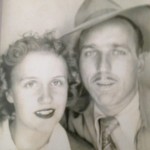 With every passing year, I find myself wondering how it could have been nine years since my mom, Collene Spencer, left us to go to Heaven. Like she lived her life, my mom went out in her own time, and in her own way…on her own terms. I’m sure that you have heard about having a bucket list. Well, my mom had her own kind of bucket list. After my dad, Allen Spencer graduated to Heaven on December 12, 2007, Mom told us that she was going to stay. I don’t know if she thought we thought she would just give up, and maybe we did to a degree, but she told us that she missed Dad very much, but she felt that she had more to give and that there was more life for her to live.
With every passing year, I find myself wondering how it could have been nine years since my mom, Collene Spencer, left us to go to Heaven. Like she lived her life, my mom went out in her own time, and in her own way…on her own terms. I’m sure that you have heard about having a bucket list. Well, my mom had her own kind of bucket list. After my dad, Allen Spencer graduated to Heaven on December 12, 2007, Mom told us that she was going to stay. I don’t know if she thought we thought she would just give up, and maybe we did to a degree, but she told us that she missed Dad very much, but she felt that she had more to give and that there was more life for her to live.
She talked about the things she wanted to do. Her bucket list was filled with simple things really. She wanted to travel to Washington to visit family up there. My Aunt Ruth and Uncle Jim were gone, but their kids, Shirley Cameron and Terry Wolfe were still there, as were their families. She wanted to see them again, so Mom, my sister, Cheryl Masterson and I went in 2013. It was a good trip, even if part of it included my Uncle Jim’s funeral. The next year, we took her to Wisconsin to she family up in the Superior, Wisconsin area. We reconnected with so many people, and had a lovely time, making lasting cousin friendships. Mom got to reconnect her brother-in-law, Bill Spencer, her sister-in-law, Doris Spencer, as well and good cousin friends, Les 
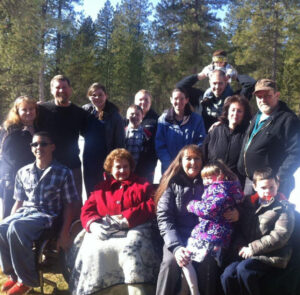 and Bev Schumacher, Carol Carlson, Bernice Hutchison, and several of their family members. Mom was so happy to see her relatives on that side of the family, who had become her close friends too.
and Bev Schumacher, Carol Carlson, Bernice Hutchison, and several of their family members. Mom was so happy to see her relatives on that side of the family, who had become her close friends too.
Mom had always said that she wouldn’t mind going to Heaven straight from church, and she almost did. On Thursday of that last week, we took Mom to dinner at Red Lobster (one of her favorite places). Then, on Sunday, we all went to church, as we always did, but this day was to be different. Mom’s sister, Evelyn Hushman was in the hospital. She had terminal Breast Cancer, and Mom wanted to get all of her remaining siblings to meet at the hospital to have lunch with Aunt Evelyn. They were all able to make it, except Aunt Dixie Richards. They all had a lovely lunch, and really enjoyed the visit. That night, Mom and my sister, Cheryl had a nice dinner and watched a movie. At 10:00pm, Mom said she was going to bed. Cheryl loaded the dishwasher and went in to take Mom her pills, but Mom would no longer be needing those pills, or any other pills. She was lying on the floor, peacefully. She had not fallen, because nothing was disturbed. She could not have laid down 
 there by herself, because her knees would never have allowed that without disturbing everything in the room. You can say what you will, but we know that the angels carefully laid our mom down there on the floor, when they took her spirit to Heaven, because Mom was ready to go. She had been talking about it for weeks, if not months. I think she might have left during church, had it not been for the chance to say goodbye to her siblings. What a blessed way for a blessing of a lady to graduate to Heaven!! We love and miss you so much, Mom. Tell Dad we love and miss him too. You are in our future now, and we will see you both again someday.
there by herself, because her knees would never have allowed that without disturbing everything in the room. You can say what you will, but we know that the angels carefully laid our mom down there on the floor, when they took her spirit to Heaven, because Mom was ready to go. She had been talking about it for weeks, if not months. I think she might have left during church, had it not been for the chance to say goodbye to her siblings. What a blessed way for a blessing of a lady to graduate to Heaven!! We love and miss you so much, Mom. Tell Dad we love and miss him too. You are in our future now, and we will see you both again someday.

 When you think about the Civil War, you think of battles being fought back east…right? For the most part, it was. When the war began, there were 34 states, but by the end, there were 36 states. Of course, some of the Southern states, eleven to be exact, wanted to secede and form their own country. That was partly what the war was about. The Southern states wanted to keep slavery, and the Northern states did not, and because they could not agree, eleven states chose to secede, and the rest fought to keep our nation together.
When you think about the Civil War, you think of battles being fought back east…right? For the most part, it was. When the war began, there were 34 states, but by the end, there were 36 states. Of course, some of the Southern states, eleven to be exact, wanted to secede and form their own country. That was partly what the war was about. The Southern states wanted to keep slavery, and the Northern states did not, and because they could not agree, eleven states chose to secede, and the rest fought to keep our nation together.
Some of the battles were fought, however on the far western front. The first of those battles, was on February 21, 1862. In the Battle of Valverde, Confederate troops under General Henry Hopkins Sibley attacked Union troops commanded by Colonel Edward R S Canby near Fort Craig in the New Mexico Territory. This first major engagement of the Civil War in the far West, produced heavy casualties but ended with no decisive result. Of course, the battle was part of the broader movement by the Confederates to capture New Mexico and other parts of the West. The point was to secure territory that the Rebels thought was rightfully theirs, because it was part of the southern territories of the United States. This area had been denied them by political compromises made before the Civil War, which they felt was wrong. 
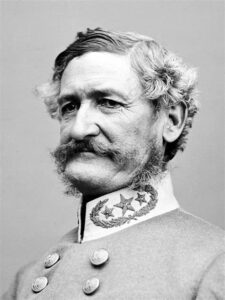
By this time, the Confederacy was quickly going broke, and they wanted to use Western mines to fill its treasury. The Rebel troops moved from San Antonio, into southern New Mexico, which at that time included Arizona, and captured the towns of Mesilla and Tucson. Sibley, with 3,000 troops, now moved north against the Federal stronghold at Fort Craig on the Rio Grande. Canby was determined to make sure the Confederates didn’t lay siege to Fort Craig. Canby knew that the Rebels were running low on supplies, and they wouldn’t last much longer. He knew that Sibley really did not have sufficiently heavy artillery to attack the fort, so when Sibley arrived near Fort Craig on February 15, he ordered his men to swing east of the fort, cross the Rio Grande, and capture the Valverde fords of the Rio Grande. He hoped to cut off Canby’s communication and force the Yankees out into the open, thereby giving the Rebels the upper hand.
For Sibley’s Rebels, things at the fords didn’t initially go as planned. Five miles north of Fort Craig, a Union detachment attacked part of the Confederate force. The Yankees pinned the Texan Rebels in a ravine and were on the verge of routing them when more of Sibley’s men arrived and turned the tide. Sibley’s second in command, Colonel Tom Green, who was filling in for Sibley, who was ill, made a bold counterattack against the Union left flank. The Yankees retreated, heading back to Fort Craig. Sibley’s men didn’t take Fort Craig either.
During the Battle of Valverde, out of 3,100 men, the Union suffered 68 killed, 160 wounded, and 35 missing. 
 The Confederates suffered 31 killed, 154 wounded, and 1 missing out of 2,600 troops. The battle was indeed bloody, but none of their objectives were accomplished, so it was virtually an indecisive battle. From Fort Craig, Sibley’s men continued up the Rio Grande winning battle after battle. Nevertheless, after capturing Albuquerque and Santa Fe, they were stopped at the Battle of Glorieta Pass on March 28, 1862.
The Confederates suffered 31 killed, 154 wounded, and 1 missing out of 2,600 troops. The battle was indeed bloody, but none of their objectives were accomplished, so it was virtually an indecisive battle. From Fort Craig, Sibley’s men continued up the Rio Grande winning battle after battle. Nevertheless, after capturing Albuquerque and Santa Fe, they were stopped at the Battle of Glorieta Pass on March 28, 1862.
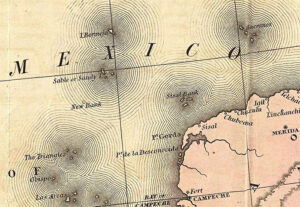
 For centuries there the maps of Mexico showed an island called Bermeja located off the north coast of the Yucatán Peninsula. It wasn’t a big island, but it was there. Then, suddenly, it wasn’t there. Now…islands don’t just disappear, so was it there, or wasn’t it, and if it was, where did it go? These days, it’s known as a phantom island. What’s interesting about this island is that a search for it found nothing that could have been called an island. While it is strange that an island was on a map and then wasn’t, I began to wonder why it mattered. There was a reason…oil rights. When a question arose concerning oil rights in the Gulf of Mexico, where the island was concerned, research started when someone pointed out that the island has no real boundaries, and therefore, no rights to oil in the Gulf of Mexico. So, authorities started looking for this piece of land, but they found only water. I’m sure that settled the question of oil rights, but it doesn’t explain whether or not the island ever existed, or if it was just an error on the old maps.
For centuries there the maps of Mexico showed an island called Bermeja located off the north coast of the Yucatán Peninsula. It wasn’t a big island, but it was there. Then, suddenly, it wasn’t there. Now…islands don’t just disappear, so was it there, or wasn’t it, and if it was, where did it go? These days, it’s known as a phantom island. What’s interesting about this island is that a search for it found nothing that could have been called an island. While it is strange that an island was on a map and then wasn’t, I began to wonder why it mattered. There was a reason…oil rights. When a question arose concerning oil rights in the Gulf of Mexico, where the island was concerned, research started when someone pointed out that the island has no real boundaries, and therefore, no rights to oil in the Gulf of Mexico. So, authorities started looking for this piece of land, but they found only water. I’m sure that settled the question of oil rights, but it doesn’t explain whether or not the island ever existed, or if it was just an error on the old maps.
Of course, no pictures of the island are known to exist. All we know is that one century, it’s sitting pretty at 22°33′ N, 91°22 E in the Gulf of Mexico and the next, it’s vanished, confounding maritime investigations and aerial surveys alike. While it may seem to many people as no big deal, the Mexican people want to know where it went. It wasn’t inhabited, so you might wonder why it is so important to know if it did and if so, where it went. The thing is that while it wouldn’t be like the island of Jamaica went missing, it still changes what the Mexican people thought they knew about their world. For some people, that is akin to having your computer have a virus, and you can’t seem to get rid of it. Ok, maybe that is extreme, but in a techy world, that would be a good comparison.
Bermeja was a common fixture on maps drawn by Spanish explorers back in the 16th and 17th centuries. Strangely, its location sometimes varied slightly and sometimes its name appeared as Vermeja, but its existence was not in question at that time. In the 18th century, however, the island’s cartographic presence started faltering, before it eventually dropped off the horizon altogether. Its last mapped appearance dates back to the 1921 edition of the Geographic Atlas of the Mexican Republic. So, what happened to it? If you ask me it eroded away, but that is just my opinion. There are many theories regarding Bermeja’s mysterious fate. Some say that “global warming” caused the island to succumb to rising sea levels. Some wonder if an underwater earthquake caused it to denigrate. Then, there is the conspiracy theory that maybe, the CIA blow it up. They theorize that with a view to expanding US sovereignty in the oil-rich Gulf the island had to go. Others say that while that might be far-fetched, perhaps it’s not entirely impossible. I suppose that given its small size it might not have taken much to blow it up.
The Mexican and United States governments negotiated a treaty to divide Hoyos de Dona in 1997. Hoyos de Dona is a stretch of international waters taking in the area where Bermeja was once believed to be located. Now, the island mattered, so the Mexican government sent an expedition out to find it. The reason…if Bermeja did exist, it would significantly extend Mexico’s maritime limits and, more importantly, its right to the oil deposits within these limits. They found nothing, and the treaty was signed. Still, there was the authorized period of delay on oil exploration and exploitation in Hoyos de Dona, giving them a little time. That period of delay is to expire in 2010, Mexico started the hunt again. The implications for the country’s economy were just too appealing to ignore.
The “hunt” consisted of three official investigations that took place in 2009. All three used the most best technologies available at that time. They left “no wave unturned and no depth unplunged.” Nevertheless, Bermeja, nor any sign that it existed, could be found. There are those who think that it’s simply time to admit that the island never existed, and maybe it was invented by early explorers to mislead their rivals. Julio Zamora, president of the Mexican Society of Geography believes so, and says, “Countries making maps in the 16th and 17th centuries published them with inaccuracies to prevent their enemies from using them.” If ships saw an island on the map, they would avoid the area, thus allowing the map-makers free run of the area. I’m not sure why that would be important, but I suppose it’s possible, but Irasema Alcántara, from the Geography Institute at the Universidad Nacional Autónoma de México (UNAM), disagrees, saying “We’ve encountered 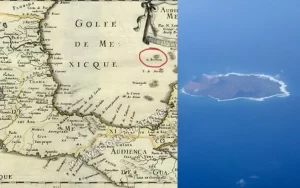
 documents containing very precise descriptions of Bermeja’s existence. On this basis we firmly believe that the island did exist, but in another location.” Well, now, that puts a whole new spin on an otherwise totally confusing situation. Maybe, we should just leave well enough alone and say, “Now you see it, now you don’t.” Highly unlikely.
documents containing very precise descriptions of Bermeja’s existence. On this basis we firmly believe that the island did exist, but in another location.” Well, now, that puts a whole new spin on an otherwise totally confusing situation. Maybe, we should just leave well enough alone and say, “Now you see it, now you don’t.” Highly unlikely.

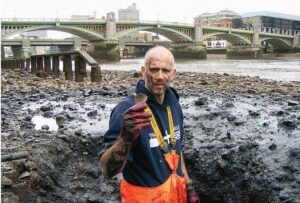 Not all age-old occupations are extinct. While we no longer need the knocker-up to make sure we are awake for work, due to the invention of the alarm clock, there will always be scavengers out there looking for lost treasure. Most of them probably don’t scavenge in the mud, but some do. It is a hobby that lots of people enjoy, but not exactly an occupation anymore. Nevertheless, there is money to be made doing it.
Not all age-old occupations are extinct. While we no longer need the knocker-up to make sure we are awake for work, due to the invention of the alarm clock, there will always be scavengers out there looking for lost treasure. Most of them probably don’t scavenge in the mud, but some do. It is a hobby that lots of people enjoy, but not exactly an occupation anymore. Nevertheless, there is money to be made doing it.
Originally, Mudlarking…or the scavenging of the river mud for items of value, was principally undertaken in London, along the river Thames. Most commonly, it was young boys from the 1700s to the early 1900s. While mudlarking would be a suitable way for young boys to make some money, the infatuation would not likely last very long. They could help their family make ends meet, it was no get rich quick endeavor. These days, mudlarking is simply a leisure activity.
In March 1904 author Dorothy Menpes wrote about London’s Mudlarks, her work published in the Batley  Reporter and Guardian, “Among London children are the mud-larks, the small scavengers of the Thames, generally clothed in scanty jackets, sunshine, and mud, wriggling unceasingly in and out of chains and anchors, and curling round the figureheads of the barges, never for one moment still, slippery and elusive as eels. They are very mischievous sprites, these children, always appearing where you least expect them, always ferreting about with those terribly keen black eyes of theirs, and frequently swooping down like seagulls upon some hidden treasure embedded in the mud; and their chief anxiety seems to consist in evading the Thames police. The Mudlarks of the Thames were a unique community, with a ‘language of their own,'” as Menpes details, “…it is a special mud-lark patois, and appears to be a mixture of the swear-words of sailors and the slang of landsmen. There are generally fights going on among these urchins for the possession of some treasure; and their constant enemies are the bargees, whom they delight to cheat and annoy by clinging to ropes and chains, thereby getting a ride gratis, as a street boy does on a Putney bus.”
Reporter and Guardian, “Among London children are the mud-larks, the small scavengers of the Thames, generally clothed in scanty jackets, sunshine, and mud, wriggling unceasingly in and out of chains and anchors, and curling round the figureheads of the barges, never for one moment still, slippery and elusive as eels. They are very mischievous sprites, these children, always appearing where you least expect them, always ferreting about with those terribly keen black eyes of theirs, and frequently swooping down like seagulls upon some hidden treasure embedded in the mud; and their chief anxiety seems to consist in evading the Thames police. The Mudlarks of the Thames were a unique community, with a ‘language of their own,'” as Menpes details, “…it is a special mud-lark patois, and appears to be a mixture of the swear-words of sailors and the slang of landsmen. There are generally fights going on among these urchins for the possession of some treasure; and their constant enemies are the bargees, whom they delight to cheat and annoy by clinging to ropes and chains, thereby getting a ride gratis, as a street boy does on a Putney bus.”
They would have to dig around in the mud looking for their treasures, because back then, they didn’t have 
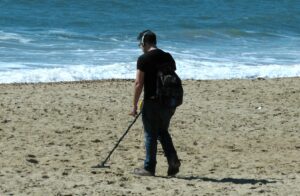 things like metal detectors. The Mudlarks (or scavengers) of today can simply walk along the beach, their yard, or the trail they are walking on to find possible treasures with very little effort. I suppose that the Mudlarks of old might say that the scavengers of today cheat to find their treasure, but as technology comes about, the game changes. It’s just the name of the game.
things like metal detectors. The Mudlarks (or scavengers) of today can simply walk along the beach, their yard, or the trail they are walking on to find possible treasures with very little effort. I suppose that the Mudlarks of old might say that the scavengers of today cheat to find their treasure, but as technology comes about, the game changes. It’s just the name of the game.
 In the realm of “odd jobs,” we find that some jobs were not just odd, some were downright cruel. I know that some of the Egyptian slaves were covered in honey, so the flies bothered them and not Pharoah. Of course, that was not really an occupation, because they were slaves. I’m sure there were a number of other things slaves were subjected to that were equally as cruel, and they just had no say in the matter.
In the realm of “odd jobs,” we find that some jobs were not just odd, some were downright cruel. I know that some of the Egyptian slaves were covered in honey, so the flies bothered them and not Pharoah. Of course, that was not really an occupation, because they were slaves. I’m sure there were a number of other things slaves were subjected to that were equally as cruel, and they just had no say in the matter.
In the world of monarchies of the past, while people weren’t slaves, there were a number of odd occupations. I simply can’t imagine choosing the occupation of “whipping boy.” Apparently, it was thought, in times past, that while princes needed discipline, and the discipline of choice in the past was spanking, one should never spank a prince. So, when a prince needed discipline for fracturing the rules, instead of 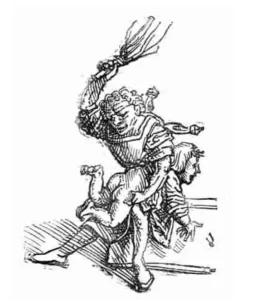 the naughty royal, there was a “whipping boy,” who had the unfortunate job of stepping up to receive the punishment for the prince.
the naughty royal, there was a “whipping boy,” who had the unfortunate job of stepping up to receive the punishment for the prince.
Now, I don’t know about you, but if I was going to have that job, I would want to be well compensated, because I’m not real fond of spankings, and since the prince wasn’t getting the spanking, who knows how hard the spanking was. I suppose it was dependent on what rule was broken, but since I wouldn’t have broken said rule, I wouldn’t be really happy about any punishment. To make matters worse, what if the prince simply enjoyed seeing the whipping boy get spanked? Some princes, have a tendency to feel entitled, and might enjoy watching someone get punished for something the prince did. It’s really not a position anyone wants to find themselves in…especially if they weren’t given any choice in the matter.
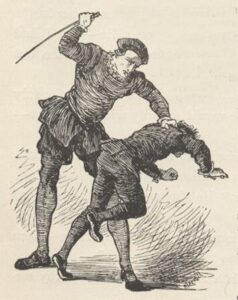
The whipping boy had the advantage of being educated alongside the prince, so I suppose that was one good thing. The boys most likely became friends, so the whipping boy could hope that seeing a friend punished would provide an equivalent motivation for the prince not to repeat the offence. Whipping was a common punishment administered by tutors in early to modern Europe. This was not a highly documented occupation, and some princes were indeed whipped by their tutors, although some people suggest that nobles might have been beaten less often than other pupils. Some historians don’t even believe that such an occupation existed either. Others believe that if it does exist, the use of a whipping boy was only applied only in the case of a boy king, protected by divine right, and not to mere princes. Whatever the case may be, I don’t think “whipping boy” would be an occupation I would want to have, nor would I want it for my child.
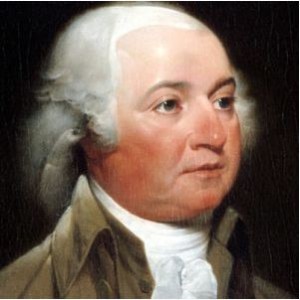
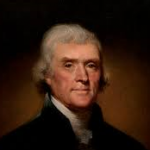 With the election of Thomas Jefferson as third president, on February 17, 1801, came the first peaceful transfer of power from one political party to another in the United States. Nevertheless, the election was an unusual one. By this time, Jefferson had helped to draft the Declaration of Independence, had served in two Continental Congresses, as minister to France, as secretary of state under George Washington and as John Adams’ vice president. These credentials probably made him the best person for the job in the entire world.
With the election of Thomas Jefferson as third president, on February 17, 1801, came the first peaceful transfer of power from one political party to another in the United States. Nevertheless, the election was an unusual one. By this time, Jefferson had helped to draft the Declaration of Independence, had served in two Continental Congresses, as minister to France, as secretary of state under George Washington and as John Adams’ vice president. These credentials probably made him the best person for the job in the entire world.
While it was obvious that Jefferson was the best man for the job, vicious partisan warfare was the name of the game during the campaign of 1800 between Democratic-Republicans Jefferson and Aaron Burr and Federalists John Adams, Charles C Pinckney and John Jay. The ongoing battle raged between Democratic-Republican supporters of the French, who were involved in their own bloody revolution, and the pro-British Federalists who wanted to implement English-style policies in American government. The Federalists hated the French revolutionaries because of their overzealous use of the guillotine and, as a result, were less forgiving in their foreign policy toward the French. They pushed for a strong centralized government, a standing military, and financial support of emerging industries.
Jefferson’s Democratic-Republicans, on the other hand, preferred limited government, complete and absolute states’ rights and a primarily agricultural economy. They feared that Federalists would abandon revolutionary ideals and revert to the English monarchical tradition. When Jefferson was secretary of state under Washington, he opposed Secretary of the Treasury Hamilton’s proposal to increase military expenditures and resigned when Washington supported the leading Federalist’s plan for a national bank.
A bloodless, but ugly campaign ensued, in which candidates and influential supporters on both sides used the press, often anonymously, as a forum to fire slanderous volleys at each other. It sounds a lot like some of our election campaigns of today. Then came the laborious and confusing process of voting, that began in April 1800. Individual states scheduled elections at different times, which I think further confuses the situation, and although Jefferson and Burr ran on the same ticket, as president and vice president respectively, the Constitution still demanded votes for each individual to be counted separately. As a result, by the end of January 1801, Jefferson and Burr emerged tied at 73 electoral votes apiece. Adams came in third at 65 votes. While that left Adams out, it left a tie for Jefferson and Burr. The result created a big problem.
The resulting tie sent the final vote to the House of Representatives. That would not make for an easy decision e ither. A number of those in the Federalist-controlled House of Representatives insisted on following the Constitution’s flawed rules and refused to elect Jefferson and Burr together on the same ticket. The highly influential Federalist Alexander Hamilton, who mistrusted Jefferson, but hated Burr more, persuaded the House to vote against Burr, whom he called the most unfit man for the office of president. Of course, that cause a hatred between Hamilton and Burr that led Burr to challenge Hamilton to a duel in 1804. Burr won the duel when he killed Hamilton. Two weeks before the scheduled inauguration, Jefferson emerged victorious, and Burr was confirmed as his vice president. It was the first of only two times the presidency has been decided by the House of Representatives.
ither. A number of those in the Federalist-controlled House of Representatives insisted on following the Constitution’s flawed rules and refused to elect Jefferson and Burr together on the same ticket. The highly influential Federalist Alexander Hamilton, who mistrusted Jefferson, but hated Burr more, persuaded the House to vote against Burr, whom he called the most unfit man for the office of president. Of course, that cause a hatred between Hamilton and Burr that led Burr to challenge Hamilton to a duel in 1804. Burr won the duel when he killed Hamilton. Two weeks before the scheduled inauguration, Jefferson emerged victorious, and Burr was confirmed as his vice president. It was the first of only two times the presidency has been decided by the House of Representatives.
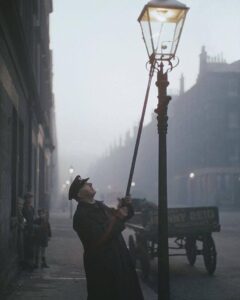 As evening arrives, and the streets grow dark, the streetlights begin to light up. When we go out to drive in the nighttime, we take for granted that the streets won’t be quite as dark as the night, because the streetlights will add a little bit of light to show you where the roads, corners, and even pedestrians are. We take all that for granted, but it wasn’t always that way. Electric streetlights came into being in Paris in 1881, but it would be quite a while before all the towns and cities of the world would have them.
As evening arrives, and the streets grow dark, the streetlights begin to light up. When we go out to drive in the nighttime, we take for granted that the streets won’t be quite as dark as the night, because the streetlights will add a little bit of light to show you where the roads, corners, and even pedestrians are. We take all that for granted, but it wasn’t always that way. Electric streetlights came into being in Paris in 1881, but it would be quite a while before all the towns and cities of the world would have them.
That brings us to the now non-existent occupation of the lamplighter. It sound self-explanatory profession from its name, but there was much more to it than simply lighting a lamp at night. Newspapers from the past can better explain the actual job of the lamplighter. When advertisements were posted for the job of lamplighter, such as the “Public Notice” which appeared in the Beeston Gazette and Echo, July 1928: “Applications are invited for the post of Lamplighter for the ensuing Lighting period. The person appointed will be required to light, extinguish, and clean the lamps. Wages £2 per week.” The Beeston Gazette and Echo of July 21, 1928, went on to say, “And so, as a lamplighter, you would be required to light lamps at dusk, extinguish them again, whilst also keeping them in good repair. This  particular position, for the parish of Gedling in Nottinghamshire, would pay £2 a week.” That would be approximately £91 ($114.64 US) in today’s money. No, the pay wasn’t great then or now, but in small towns it probably wouldn’t take long to do most of the work. Still, maintenance and cleaning added to the work.
particular position, for the parish of Gedling in Nottinghamshire, would pay £2 a week.” That would be approximately £91 ($114.64 US) in today’s money. No, the pay wasn’t great then or now, but in small towns it probably wouldn’t take long to do most of the work. Still, maintenance and cleaning added to the work.
Also, remember that the job was year-round and in every season. It wouldn’t make sense to ride a bicycle, or these days, a car, take a horse or any other vehicle to go from corner to corner lighting the lamps. So they walked, and walked!! One lamplighter named John Maher, recorded a record of 150,000 miles. His story was told in the Prescot Reporter, and Saint Helens General Advertiser. John Maher is described as one of the “unsung heroes” of Saint Helens, “whose presence in the community is taken for granted and whose necessity is rarely proclaimed.” Prescot Reporter and St. Helens General Advertiser went on to say on April 21, 1939, “For 43 years Maher has ‘been pounding the pavements of St Helens,’ during which it was estimated that he covered 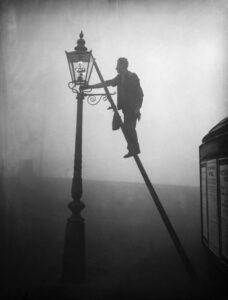 150,000 miles, in all weathers. At the age of 64, the lamplighter had…worked every hour in the day. His day commenced just before dawn and ended after sundown. He also worked four hours during the interim period cleaning, and as the times of dawn and sunset are always changing, Mr. Maher has to change the times of his going to work accordingly.”
150,000 miles, in all weathers. At the age of 64, the lamplighter had…worked every hour in the day. His day commenced just before dawn and ended after sundown. He also worked four hours during the interim period cleaning, and as the times of dawn and sunset are always changing, Mr. Maher has to change the times of his going to work accordingly.”
The life of a lamplighter was a hard one once described like this, “I may say that as a lamp-lighter I am exposed to all weathers and have a lot of broken rest and excessive walking. Everybody notices the great improvement in me since I took Phosferine. I continue the remedy regularly twice a day, and I would not be without it on any account, as I consider it has given me a new lease of life.” Apparently, the job was so hard that many lamplighters took some sort of medicine to make it through their days. Clearly, we can consider ourselves blessed to have electric streetlights these days.
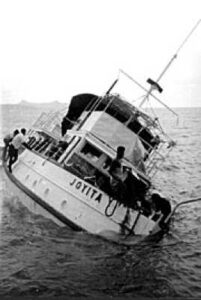 MV Joyita, an American merchant vessel, was acquired by the United States Navy in October of 1941. She was not a big ship and only ran with a crew of 25 men. Joyita was a 69-foot wooden ship built in 1931 as a luxury yacht by the Wilmington Boat Works in Los Angeles. She was originally built for movie director Roland West, who named the ship for his wife, actress Jewel Carmen. The word “joyita” in Spanish meaning “little jewel.” The ship’s hull was constructed of 2-inch-thick cedar on oak frames. She was 69 feet long, with beam of 17 feet and a draft of 7 feet 6 inches. her net tonnage was 47 tons and her gross tonnage approximately 70 tons. She had tanks for 2,500 US gallons of water and 3,000 US gallons of diesel fuel. In 1936 West sold the ship to Milton E Beacon. During this period, she made numerous trips south to Mexico and to the 1939–1940 Golden Gate International Exposition in San Francisco. During part of this time, Chester Mills was the captain of the vessel.
MV Joyita, an American merchant vessel, was acquired by the United States Navy in October of 1941. She was not a big ship and only ran with a crew of 25 men. Joyita was a 69-foot wooden ship built in 1931 as a luxury yacht by the Wilmington Boat Works in Los Angeles. She was originally built for movie director Roland West, who named the ship for his wife, actress Jewel Carmen. The word “joyita” in Spanish meaning “little jewel.” The ship’s hull was constructed of 2-inch-thick cedar on oak frames. She was 69 feet long, with beam of 17 feet and a draft of 7 feet 6 inches. her net tonnage was 47 tons and her gross tonnage approximately 70 tons. She had tanks for 2,500 US gallons of water and 3,000 US gallons of diesel fuel. In 1936 West sold the ship to Milton E Beacon. During this period, she made numerous trips south to Mexico and to the 1939–1940 Golden Gate International Exposition in San Francisco. During part of this time, Chester Mills was the captain of the vessel.
In October 1941, two months before the attack on Pearl Harbor, Joyita was acquired by the United States Navy and taken to Pearl Harbor, Hawaii, where she was outfitted as yard patrol boat YP-108. The Navy used her to patrol the Big Island of Hawaii until the end of World War II. In 1943 she ran aground and was heavily damaged, but the Navy was badly in need of ships, so she was repaired. At this point, new pipework was made from galvanized iron instead of copper or brass. In 1946, the ship was surplus to Navy requirements and most of her equipment was removed. 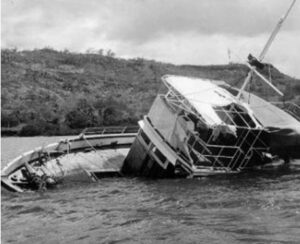
She was decommissioned and in 1948, Joyita was sold to the firm of Louis Brothers. They added a cork lining was added to the ship’s hull along with refrigeration equipment. The ship also had two Gray Marine diesel engines providing 225 horsepower, and two extra diesel engines for generators. Joyita was sold to William Tavares in 1950, but he decided he didn’t really need it, so he sold it in 1952 to Dr Katharine Luomala, a professor at the University of Hawaii. Luomala chartered the boat to her friend, Captain Thomas H “Dusty” Miller, a British-born sailor living in Samoa.
Miller used the ship as a trading and fishing charter boat. About 5:00 AM on October 3, 1955, Joyita left Samoa’s Apia harbor bound for the Tokelau Islands, about 270 miles away. They got a late start, because her port engine clutch failed. Joyita eventually left Samoa on one engine. She was carrying sixteen crew members and nine passengers, including a government official, a doctor (Alfred “Andy” Denis Parsons, a World War II 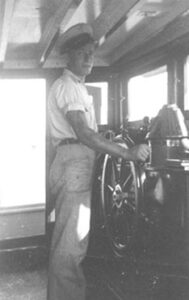 surgeon on his way to perform an amputation), a copra buyer, and two children. Her cargo consisted of medical supplies, timber, 80 empty 45-gallon oil drums, and various foodstuffs. Joyita was scheduled to arrive in the Tokelau Islands on October 5th, after an expected voyage of 41 and 48 hours. On October 6th, a message from Fakaofo port reported that the ship was overdue. No distress signal from the crew was ever received. A search-and-rescue mission was launched and, from October 6th to 12th, Sunderlands of the Royal New Zealand Air Force covered a probability area of nearly 100,000 square miles of ocean, but no sign of Joyita or any of her passengers or crew was found. Five weeks later, on November 10th, Gerald Douglas, captain of the merchant ship Tuvalu, en route from Suva to Funafuti, sighted Joyita more than 600 miles west from her scheduled route, drifting north of Vanua Levu. The ship was partially submerged and listing heavily (her port deck rail was awash) and there was no trace of any of the passengers or crew. Also missing was her four tons of cargo. The recovery party noted that the radio was discovered tuned to 2182 kHz, the international marine radiotelephone distress channel. No sign of the passengers or crew was ever found.
surgeon on his way to perform an amputation), a copra buyer, and two children. Her cargo consisted of medical supplies, timber, 80 empty 45-gallon oil drums, and various foodstuffs. Joyita was scheduled to arrive in the Tokelau Islands on October 5th, after an expected voyage of 41 and 48 hours. On October 6th, a message from Fakaofo port reported that the ship was overdue. No distress signal from the crew was ever received. A search-and-rescue mission was launched and, from October 6th to 12th, Sunderlands of the Royal New Zealand Air Force covered a probability area of nearly 100,000 square miles of ocean, but no sign of Joyita or any of her passengers or crew was found. Five weeks later, on November 10th, Gerald Douglas, captain of the merchant ship Tuvalu, en route from Suva to Funafuti, sighted Joyita more than 600 miles west from her scheduled route, drifting north of Vanua Levu. The ship was partially submerged and listing heavily (her port deck rail was awash) and there was no trace of any of the passengers or crew. Also missing was her four tons of cargo. The recovery party noted that the radio was discovered tuned to 2182 kHz, the international marine radiotelephone distress channel. No sign of the passengers or crew was ever found.

 While some people think that Valentine’s Day is just another “far to commercialized” holiday, I like the idea of telling those you love, that you are thinking of them today. Yes, we should be thinking of them every day, and most of us do that, but to set aside a day to give that little extra, whether it is a card, candy, jewelry, dinner, or just time together is one more chance of letting them know that they are valued. I see no harm in giving just a little bit extra one day a year. You never know how deeply that will affect them. They might be having a really bad day, or just feeling lonely. Life is about connecting with our loved ones, and finding little ways of making them feel loved.
While some people think that Valentine’s Day is just another “far to commercialized” holiday, I like the idea of telling those you love, that you are thinking of them today. Yes, we should be thinking of them every day, and most of us do that, but to set aside a day to give that little extra, whether it is a card, candy, jewelry, dinner, or just time together is one more chance of letting them know that they are valued. I see no harm in giving just a little bit extra one day a year. You never know how deeply that will affect them. They might be having a really bad day, or just feeling lonely. Life is about connecting with our loved ones, and finding little ways of making them feel loved.
Of course, there is the romantic side of the coin too. Telling our spouse or partner just how important they are to us is so important. Some people think you have to go all out, and I suppose that is part of the problem people have with the day, but I think that some of the sweetest token of affection can be hand-made cards. I think most people have years when things are a little tighter, and if your spouse or partner really loves you, they don’t want to see anyone go crazy in debt for the day. A home-cooked dinner by candlelight can be super romantic, but skipping the day because you think it’s corny…just not cool.
Whatever you choose to do, don’t be the Valentine’s Day version of Scrooge, because that will land you quickly in the doghouse, and I seriously doubt that it will be covered with paper hearts and filled with chocolate candy. The doghouse is not the place anyone wants to spend the holiday that is known for love, unless your valentine 
 is your dog, that is. I suppose that your dog could be your valentine, but my suggestion is that if your dog is your valentine, you had better get your sweet pup an extra serving of Kibble, or you might find yourself kicked to the curb…or sleeping in the kennel for the night!! Whatever you do to celebrate the day, I hope it finds you sharing it with someone you really love. Happy Valentine’s Day everyone!! Have a lovely day!!
is your dog, that is. I suppose that your dog could be your valentine, but my suggestion is that if your dog is your valentine, you had better get your sweet pup an extra serving of Kibble, or you might find yourself kicked to the curb…or sleeping in the kennel for the night!! Whatever you do to celebrate the day, I hope it finds you sharing it with someone you really love. Happy Valentine’s Day everyone!! Have a lovely day!!
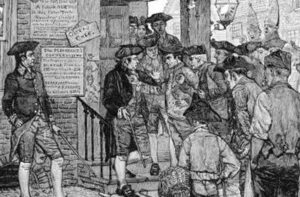
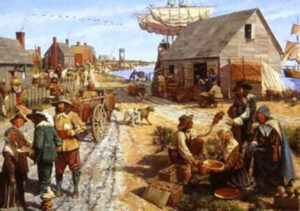 If you travel to a different area of the country or even other English-speaking areas of the world, you will find that here are different accents and even that words are used differently. Still, just because you are visiting or move to those places, doesn’t mean that you will immediately take on those accents, or their use of words. Nevertheless, when you move to a different region, your use of the language does immediately begin to evolve, whether you realize it or not, and whether it is intentional or not. The first Englishmen to set foot on American soil with the intent to colonize the land were no exception. The language began to evolve almost immediately….and it remains a fluid, almost living process to this day. “Americanisms” have been created or changed from other English terms to produce a language that very much differs from our forefathers, signifying our uniqueness and independence.
If you travel to a different area of the country or even other English-speaking areas of the world, you will find that here are different accents and even that words are used differently. Still, just because you are visiting or move to those places, doesn’t mean that you will immediately take on those accents, or their use of words. Nevertheless, when you move to a different region, your use of the language does immediately begin to evolve, whether you realize it or not, and whether it is intentional or not. The first Englishmen to set foot on American soil with the intent to colonize the land were no exception. The language began to evolve almost immediately….and it remains a fluid, almost living process to this day. “Americanisms” have been created or changed from other English terms to produce a language that very much differs from our forefathers, signifying our uniqueness and independence.
Of course, the people didn’t notice the changes right away, but by 1720, the English colonists began to notice that their language was quite different from that spoken in their Motherland. I’m sure they wondered just how that came to be? Basically, when you hear new “slang” words, and people don’t hear the accents spoken as well, the whole dynamic of the language changes. Also, very formal words like “thee, thou, and such” might become too cumbersome and so they are discarded. Everyone in the colonies knew that English would be our native language by 1790, because when the United States took its first census, there were four million Americans, 90% of whom were descendants of English colonists. So, it made perfect sense.
Nevertheless, it would not be the same as that spoken in Great Britain. The reasons are varied, but the most obvious reason was the sheer distance from England. The main way the language evolved was that over the years, many words were borrowed from the Native Americans, as well as other immigrants from France, Germany, Spain, and other countries. In addition, words that became obsolete “across the pond” continued to be utilized in the colonies. In other cases, words simply had to be created in order to explain the unfamiliar landscape, weather, animals, plants, and living conditions that these early pioneers encountered. By 1790 it was obvious that American English would be a very different language that British English.
The first “official” reference to the “American dialect” was made in 1756 by Samuel Johnson, a year after he published his Dictionary of the English Language. Johnson’s use of the term “American dialect” was not meant to simply explain the differences but rather, was intended as an insult. This “new” language was called “barbarous” and referred to our “Americanisms” as barbarisms. Because of the dissention between England and the Colonies, the British sneering at our language continued for more than a century after the Revolutionary War. They laughed and condemned as unnecessary, hundreds of American terms and phrases, but to our newly independent Americans, they were proud of their “new” American language and considered it to be another badge of independence. In 1789, Noah Webster wrote in his Dissertations on the English Language, “The reasons for American English being different than English English are simple…As an independent nation, our honor requires us to have a system of our own, in language as well as government.” In the eyes of the Colonists, that settled the matter, and when the United States was formed, the new nation was proud to be separated for the “Motherland” and would have it no other way.
Our leaders, including Thomas Jefferson and Benjamin Rush, agreed — it was not only good politics, but it was also sensible. The most atrocious changes to the British were the heavy use of contractions such as ain’t, can’t, don’t, and couldn’t. The feelings of the “rest of the world” didn’t matter to Americans, and the language changed even more during the western movement as numerous Native American and Spanish words became an everyday part of our language. The evolution of the American language continued into the 20th century and really continues even to this day. After World War I, when Americans were in a patriotic and anti-foreign mood, the state of Illinois went so far as to pass an act making the official language of the state the “American language.” In 1923, in the State of Illinois General Assembly, they passed the act stating in part, “The official language of the State of Illinois shall be known hereafter as the ‘American’ language and not as the ‘English’ 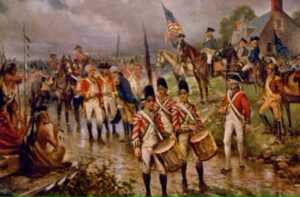
 language. A similar bill was also introduced in the US House of Representatives the same year but died in committee. Ironically, after centuries of forming our ‘own’ language, the English and American versions are once again beginning to blend as movies, songs, electronics, and global traveling bring the two ‘languages’ closer together.”
language. A similar bill was also introduced in the US House of Representatives the same year but died in committee. Ironically, after centuries of forming our ‘own’ language, the English and American versions are once again beginning to blend as movies, songs, electronics, and global traveling bring the two ‘languages’ closer together.”

